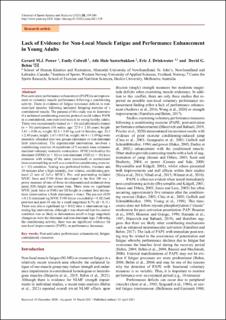Lack of evidence for non-local muscle fatigue and performance enhancement in young adults
Peer reviewed, Journal article
Published version

Åpne
Permanent lenke
https://hdl.handle.net/11250/2978866Utgivelsesdato
2021Metadata
Vis full innførselSamlinger
- Import fra CRIStin [3604]
- Institutt for idrett, kosthald og naturfag [1006]
Originalversjon
Power, G. M. J., Colwell, E., Saeterbakken, A. H., Drinkwater, E. J., & Behm, D. G. (2021). Lack of Evidence for Non-Local Muscle Fatigue and Performance Enhancement in Young Adults. Journal of Sports Science and Medicine, 20, 339-348. 10.52082/jssm.2021.339Sammendrag
Post-activation performance enhancement (PAPE) is an improvement to voluntary muscle performance following a conditioning activity. There is evidence of fatigue resistance deficits in non-exercised muscles following unilateral fatiguing exercise of a contralateral muscle. The purpose of this study was to determine if a unilateral conditioning exercise protocol could induce PAPE in a contralateral, non-exercised muscle in young healthy adults. Thirty-two recreationally trained (n = 16) and athletically trained (n = 16) participants (16 males; age: 22.9 ± 2.03 years; height: 1.81 ± 0.06 m; weight: 82.8 ± 9.43 kg, and 16 females; age: 23.1 ± 2.80 years; height: 1.67 ± 0.07 m; weight: 66.4 ± 11.09 kg) were randomly allocated into two groups (dominant or non-dominant limb intervention). The experimental intervention, involved a conditioning exercise (4-repetitions of 5-seconds knee extension maximal voluntary isometric contractions: MVIC) with either the dominant (DOM) (n = 16) or non-dominant (ND) (n = 16) knee extensors with testing of the same (exercised) or contralateral (non-exercised) leg as well as a control (no conditioning exercise: n = 32) condition. Testing was performed before, 1-minute and 10-minutes after a high intensity, low volume, conditioning protocol (2 sets of 2x5-s MVIC). Pre- and post-testing included MVIC force and F100 (force developed in the first 100 ms: a proxy measure of rate of force development) and unilateral drop jump (DJ) height and contact time. There were no significant MVIC peak force or EMG nor DJ height or contact time interactions (intervention x limb dominance x time). The pre-test (0.50 ± 0.13) dominant leg MVIC F100 forces exceeded (p = 0.02) both post-test and post-10 min by a small magnitude 8.7% (d = 0.31). There was also a significant (p = 0.02) time x intervention leg x testing leg intervention, although it was observed that the control condition was as likely to demonstrate small to large magnitude changes as were the dominant and non-dominant legs. Following the conditioning activity, there was no significant evidence for non-local improvements (PAPE), or performance decreases.